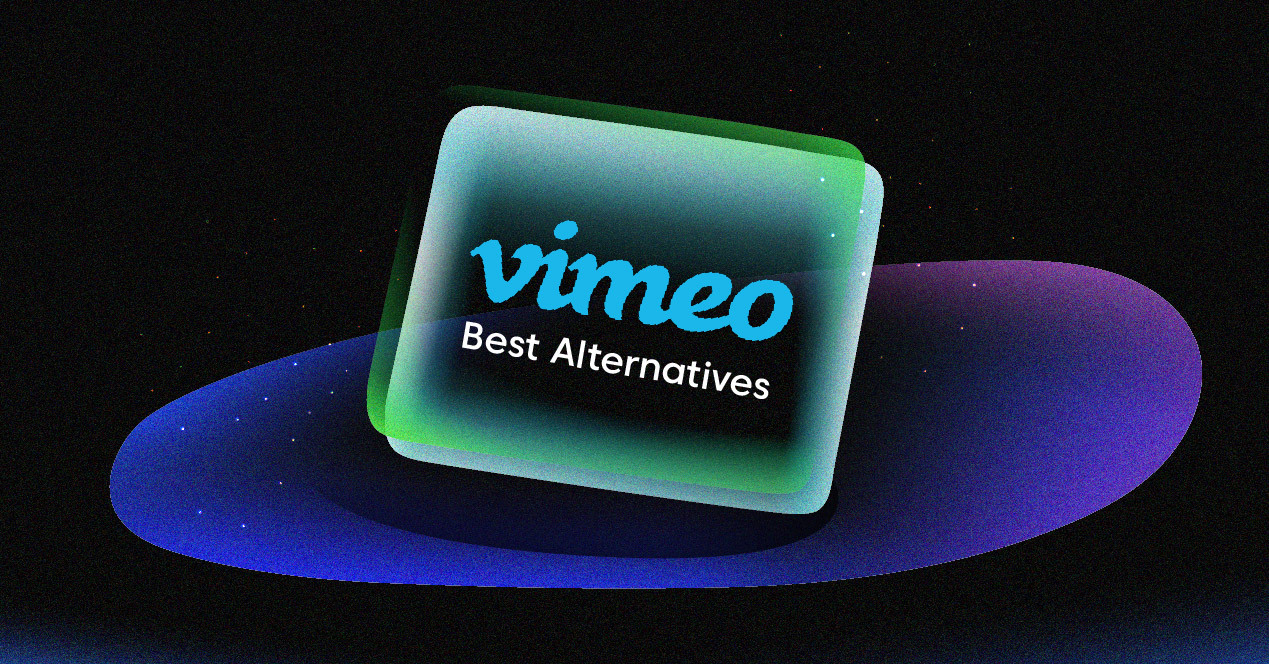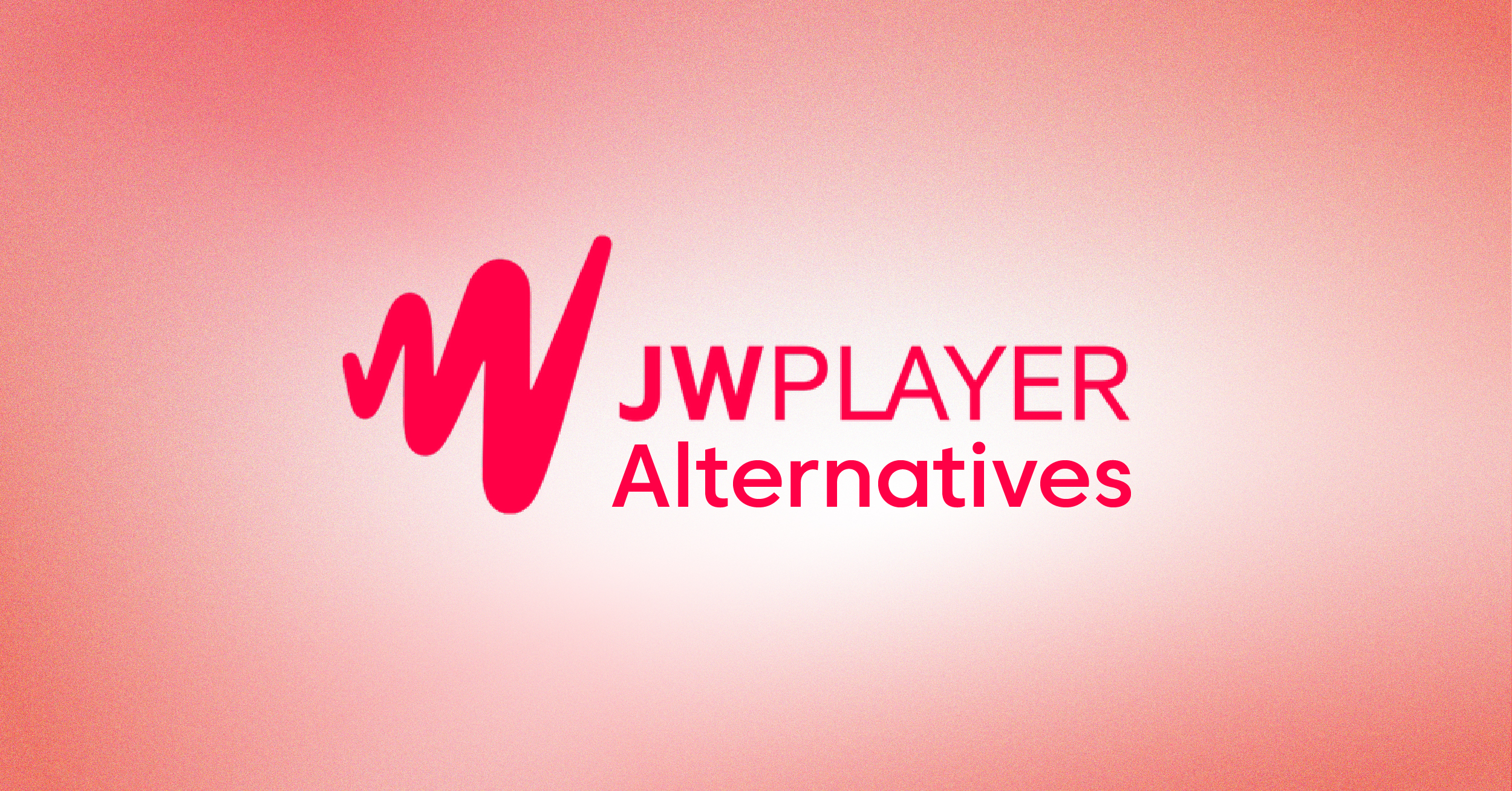The world of video content creation and distribution is evolving at an unprecedented rate. Vimeo and its competitors are leading online video platforms, but while Vimeo has been a go-to platform for many, its pricing, limited features, and sometimes spotty customer support have led users to seek alternatives.
Many users want to compare Vimeo with other platforms to see which best fits their needs. Luckily, there are plenty of fantastic Vimeo alternatives available that offer similar or even better features—and often at a more affordable price. Whether you’re hosting marketing videos, educational content, company communications, or creative projects, there’s a platform tailored to your needs.
In this guide, we’ll walk you through the 10 best Vimeo alternatives, helping you find a great Vimeo alternative and a solid Vimeo alternative by highlighting the comparative advantages of each online video platform, so you can see the perfect video platform to fit your goals and make your content shine.
What is Vimeo?
Vimeo is a professional video hosting platform that launched in 2004, predating YouTube. It positions itself as a premium service for creators, businesses, and professionals who need high-quality video hosting without ads.

The platform offers features for video creation, editing, hosting, and sharing. Vimeo provides a range of solutions, including on-demand videos, live streaming, customizable video players, privacy controls, analytics, and various pricing plans for individuals and businesses.
Vimeo has evolved from a creator-focused platform to a comprehensive video solution for businesses. It now offers tools for video marketing, team collaboration, and content monetization. The platform serves over 1.7M+ users worldwide.
The service operates on a freemium model with tiered pricing plans. These range from a limited free plan to premium subscriptions costing over $100 monthly. Higher-tier plans unlock features like advanced customization, live streaming, and marketing tools.
Despite its popularity, Vimeo faces criticism for its pricing transparency, the quality of customer support, and limitations on lower-tier plans. These issues have prompted many users to explore other options.
Features
- HTML5 video player with customization options
- Video-on-demand hosting with privacy controls
- Live streaming capabilities (on higher-tier plans)
- Basic video editing tools
- Team collaboration features
- Video monetization options
- Integration with marketing and social platforms
- Basic video analytics
- Mobile compatibility
- API access for developers
Pros
- Ad-free viewing experience
- Professional and clean interface
- Good video quality and playback
- Privacy controls and password protection
- White-label options (on higher plans)
- Domain-level privacy settings
- Global content delivery
Cons
- Expensive pricing for premium features
- Limited features on lower-tier plans
- Weekly upload caps
- Hidden bandwidth limitations despite “unlimited” claims
- Slow and unresponsive customer support
- Restricted customization options compared to competitors
- Basic analytics that lack depth
- Limited monetization features
10 Best Vimeo Alternatives You Can Choose
1. Castr
Castr stands out as a top alternative to Vimeo for professional video streaming and hosting. This platform delivers exceptional value with its comprehensive features and transparent pricing structure. Castr is upfront about what you get with each plan. Castr also supports live streaming, making it ideal for real-time broadcasting and audience engagement.

The platform partners with top-tier CDNs like Akamai and Fastly to ensure smooth, high-quality video delivery worldwide. This partnership guarantees minimal buffering and latency, even during high-traffic events. Castr users enjoy stable, high-definition streams that work reliably across devices and locations.
What truly sets Castr apart is its outstanding customer support. The platform offers 24/7 technical assistance through multiple channels, including Slack, Skype, and WhatsApp. This level of support proves invaluable during live events when technical issues can arise unexpectedly. Castr also offers custom branding options, enabling businesses to personalize their video player with logos and interface elements that match their brand identity.
Castr works well for various use cases, including professional broadcasters, educational institutions, businesses, and content creators. The platform’s flexibility makes it suitable for both beginners and experienced streamers looking for a reliable Vimeo alternative.
Features
- Multi-CDN delivery through Akamai and Fastly for global reach
- White-label HTML5 player with complete customization
- Live streaming support on all plans with multi-streaming capabilities
- VOD hosting with unlimited video files
- Audio streaming capabilities for comprehensive broadcast solutions
- Monetization tools, including paywall and in-stream ads
- VAST/VPAID support for advanced advertising options
- Multi-streaming to 30+ social platforms simultaneously
- SRT support for reliable streaming over unstable networks
- Adaptive bitrate (ABR) transcoding for optimal viewing experience
- Video analytics for performance tracking
- Custom domains for branded video links
- API access for developers
Pros
- No yearly commitment required—try and cancel anytime
- 24/7 dedicated technical support via Slack, Skype, and WhatsApp
- Transparent pricing with no hidden fees or limitations
- Up to 55% cost savings compared to Vimeo
- Ad-free streaming experience
- Superior stream stability and quality
- Easy migration from Vimeo with assistance
- Excellent for both live events and VOD content
Cons
- The interface might require a brief learning curve for beginners
- Mobile app not yet available (though the web version works on mobile)
2. Dacast
Dacast has positioned itself as a powerful alternative to Vimeo, excelling in both live streaming and on-demand video hosting. The platform also offers on-demand streaming, allowing viewers to access your video content at any time after a live broadcast. This platform stands out for its professional-grade features and global content delivery capabilities.

Dacast uses top-tier content delivery networks to ensure your videos reach viewers worldwide with minimal buffering. This makes it ideal for businesses and content creators who need reliable performance for their video content.
The platform offers robust security features, including password protection and geographic restrictions. These tools help protect your content while still making it accessible to your intended audience.
Monetization is another strong point for Dacast. The platform supports subscription-based, pay-per-view, and ad-based revenue models, making it easy to monetize content through various tools and integrations. This flexibility enables content creators to select the most suitable monetization strategy for their unique needs.
Features
- Global delivery through multiple CDNs
- White-label streaming with customizable players
- Video API access for custom development
- Video gallery creation tools
- Ad-free streaming options
- In-depth analytics for content performance
- Cloud-based video transcoding
- Live stream recording, video recording, and archiving
- SVOD, AVOD, and TVOD monetization models
- Mobile device support
- China video delivery capabilities
Pros
- HTML5 video player with embedding options
- Unlimited concurrent viewers
- White-label and branding options
- Strong security features
- Multiple monetization options
- Reliable customer support
- Hong Kong and China delivery
Cons
- Feature range can feel overwhelming at first
- Bandwidth costs may increase with scaling
3. IBM Cloud Video
IBM Cloud Video, formerly Ustream, delivers enterprise-grade video streaming solutions backed by IBM’s robust infrastructure. This platform caters to businesses and organizations that need reliable, scalable video hosting services and offers tailored solutions and customized pricing plans specifically for enterprise users.
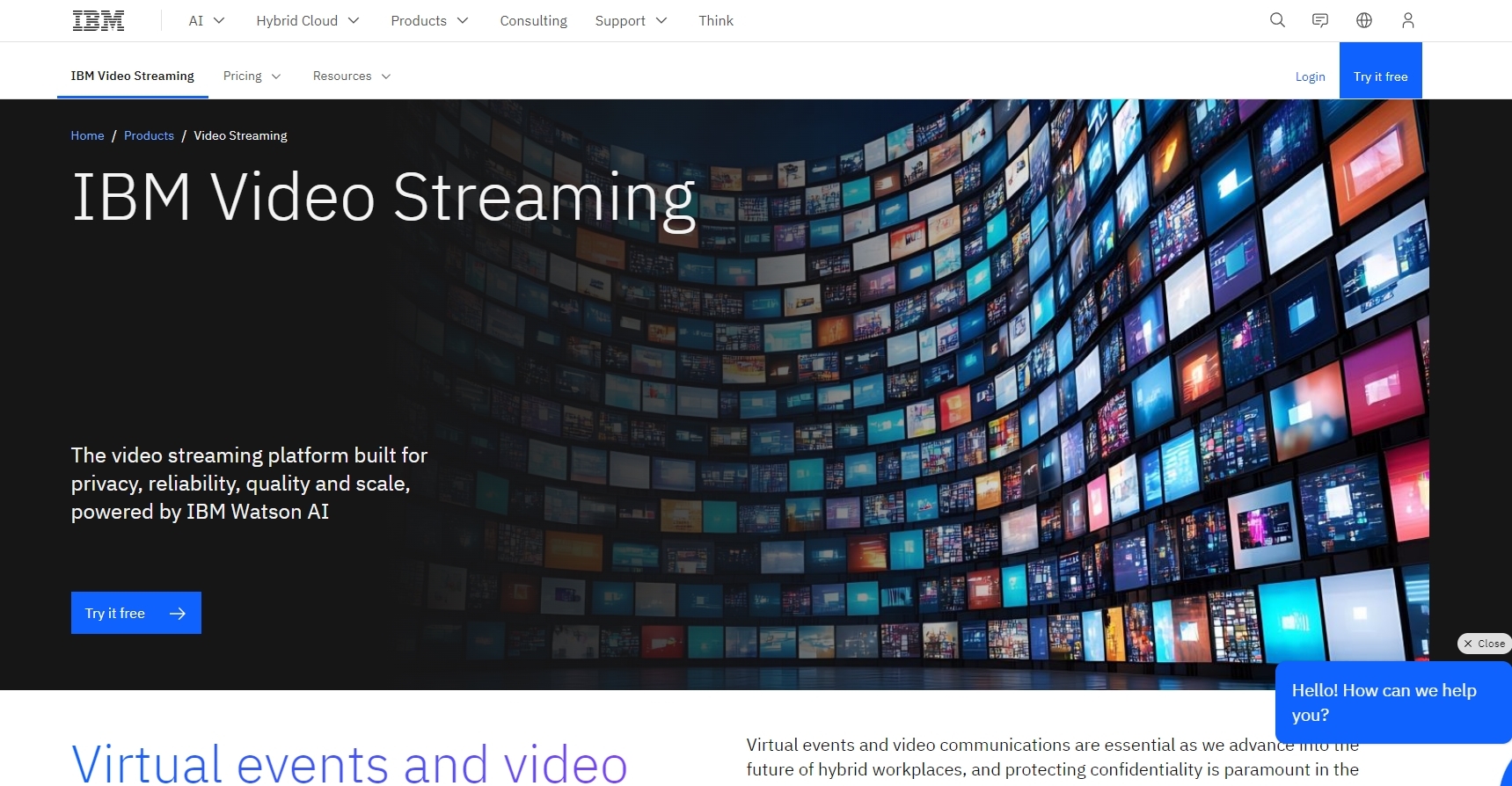
The service stands out for its exceptional reliability and security features. IBM’s global content delivery network ensures your videos stream smoothly to viewers worldwide. This makes it particularly suitable for corporate events, webinars, and high-stakes broadcasts.
IBM Cloud Video offers comprehensive analytics tools that provide detailed insights into viewer behavior and engagement. These metrics help businesses optimize their content strategy and improve ROI on their video investments.
The platform supports both live streaming and on-demand video hosting. Users can easily switch between these formats and archive live broadcasts for later viewing. This flexibility makes it a versatile choice for various use cases.
Features
- Internal global CDN structure
- HTML5 video player compatibility
- API access for customization
- Brand customization options
- Interactive video elements (chat, Q&A, polls)
- Corporate communication tools
- Integration with video conferencing platforms
- High-quality video hosting
- HD streaming capabilities
- Video content management system
- Multi-device playback support
Pros
- Reliable and stable platform
- Excellent customer support
- Professional-grade features
- Hong Kong video delivery
- Enterprise-level security
- Scalable for large organizations
Cons
- HD streaming requires plan upgrade
- Higher price point than some alternatives
- Interface can be complex for beginners
4. Kaltura
Kaltura offers a highly customizable enterprise video platform that serves educational institutions, media companies, and large businesses. Its open-source foundation provides exceptional flexibility for organizations with specific video needs. Kaltura is also well-suited for organizations with advanced broadcasting needs, offering the capacity to handle complex, high-level live streaming and broadcasting requirements.
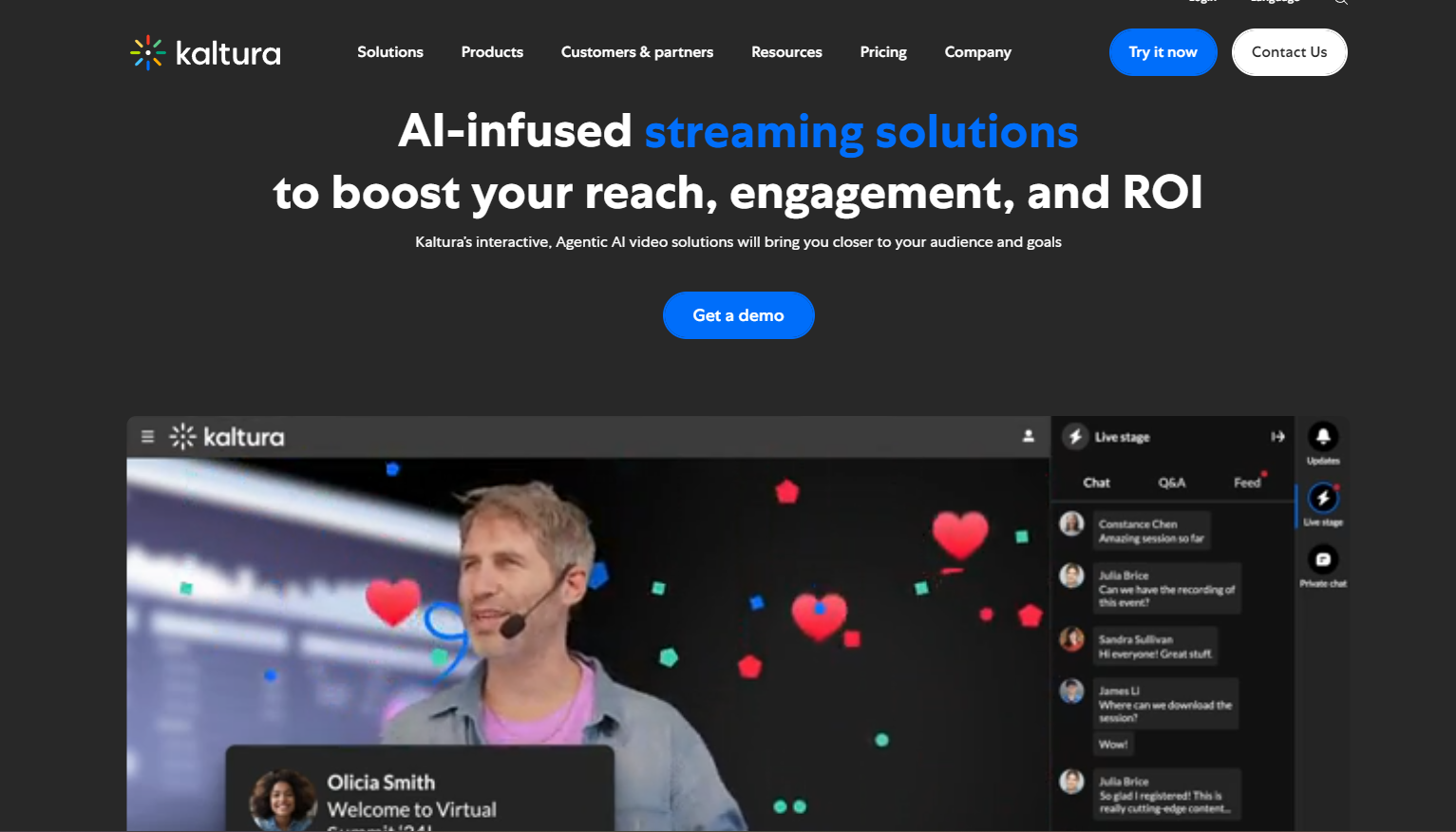
The platform stands out for its adaptability and integration capabilities. Kaltura works seamlessly with learning management systems, content management systems, and other enterprise software. This makes it particularly valuable for organizations with existing digital ecosystems.
Kaltura’s comprehensive features cover everything from video creation to distribution and analytics. Users can create, edit, and manage videos directly within the platform. The robust analytics tools provide insights into viewer engagement and content performance.
The platform supports both live streaming and on-demand videos. Its interactive features like quizzes, polls, and hotspots enhance viewer engagement. This makes Kaltura especially effective for educational content, corporate training, and hosting and delivering training videos.
Features
- Developer tools and video cloud APIs
- Comprehensive video content management system
- Ability to encode video into multiple formats
- Interactive video tools (whiteboards, notes, chat)
- Live and VOD hosting capabilities
- Multi-bitrate and adaptive streaming
- Integration with LMS platforms
- Video finder with AI-powered search
- Role-based access controls
- Interactivity tools (quizzes, surveys)
- Advanced security features
Pros
- Highly customizable for unique needs
- Extensive streaming features through integrations
- Multiple video monetization options
- Powerful video security tools
- Free video collaboration tools
- Support for educational use cases
Cons
- Can become complex with numerous integrations
- Not beginner-friendly
- Steep learning curve
- Limited Chinese delivery options
5. Wistia
Wistia specializes in marketing tools and business applications for video. A key offering is Wistia’s video marketing suite, which provides a comprehensive set of tools for professional video marketing and management. This platform enables companies to utilize video to generate leads, engage customers, and analyze viewer behavior in detail.
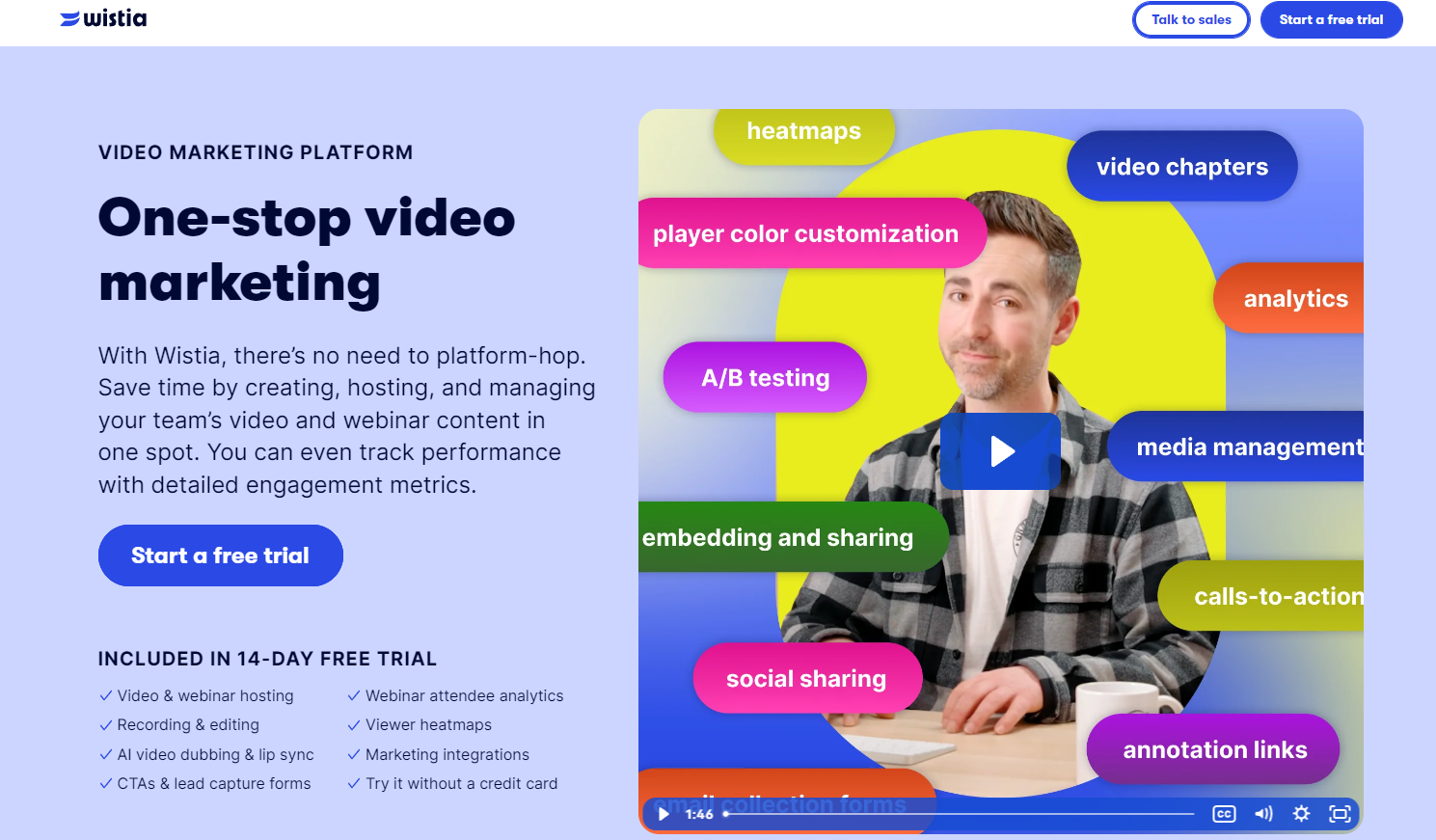
The platform stands out for its marketing-centric features. Wistia’s customizable players include email capture forms, calls-to-action, and annotation links. Additionally, Wistia enables users to easily edit videos, allowing for the creation of personalized sales pages and tailored video experiences. These tools help businesses convert viewers into leads and customers.
Wistia’s analytics go beyond basic metrics. The platform offers heatmaps that show exactly where viewers engage or drop off. A/B testing tools help optimize video performance, while viewer tracking identifies high-value leads.
The platform integrates seamlessly with popular marketing automation platforms like HubSpot, Marketo, and Mailchimp. This connectivity enables businesses to integrate video data into their comprehensive marketing strategies.
Features
- Customizable video player
- Powerful video analytics with heatmaps
- Lead capture forms
- Interactive elements such as polls and quizzes
- A/B testing capabilities
- Marketing automation integrations
- Brand customization options
- Multi-bitrate and adaptive streaming
- Advanced marketing integrations
- Video SEO tools
- Turnstile email collection
Pros
- Unlimited concurrent viewers
- Global video content delivery
- User-friendly interface
- Detailed engagement analytics
- Easy video embedding options
- Marketing-focused tools
Cons
- Only basic integrations on lower plans
- No Chinese market delivery
- Higher price point for advanced features
6. JW Player
JW Player began as a simple video player but has evolved into a comprehensive video platform. The company pioneered online video technology—YouTube’s first player was built on JW Player’s code.
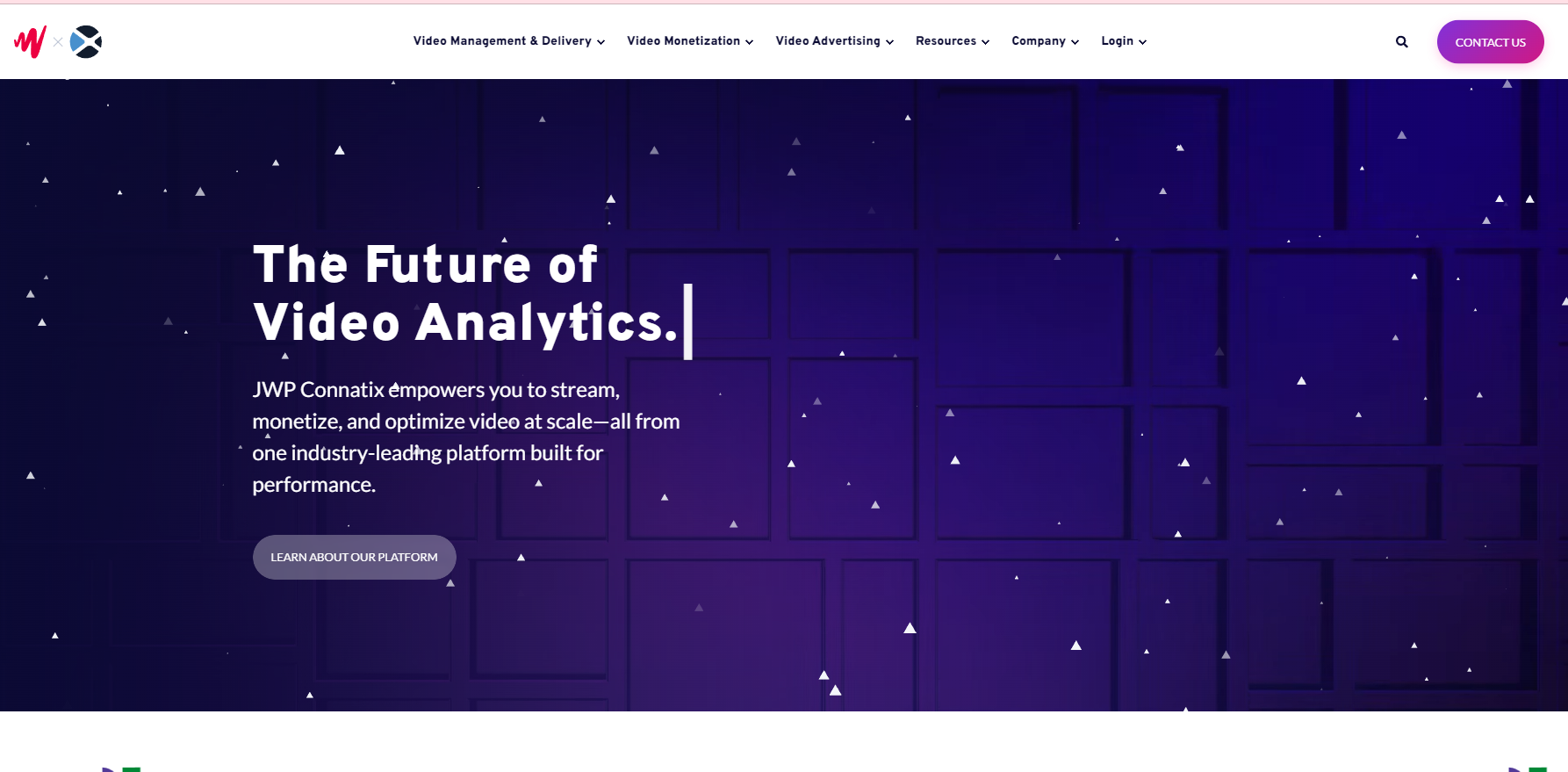
The platform stands out for its lightweight, high-performance video player. This player delivers seamless playback across devices and browsers. It supports both live streaming and on-demand videos with adaptive quality. JW Player also makes it easy for users to share videos across different channels, enabling broad distribution and audience reach.
JW Player offers robust engagement tools like recommendations, playlists, and related content suggestions. These features help keep viewers watching longer. The platform’s monetization options support various advertising formats and revenue models.
The advanced analytics provide detailed insights into viewer behavior and content performance. These metrics help content creators optimize their videos for better engagement and conversion. The platform’s API access allows for extensive customization and integration.
Features
- Advanced HTML5 video player
- Article matching and recommendation features
- Comprehensive ad monetization tools
- Advanced video analytics
- Multi-bitrate and adaptive streaming
- Content security options
- Cross-platform compatibility
- API for customization
- Video engagement tools
- Reliable ad delivery
Pros
- Powerful and efficient HTML5 player
- API customization options
- Flexible monetization options
- Simple user interface
- Content security features
- Reliable advertising tools
- Cross-platform compatibility
Cons
- Limited to ad-based monetization
- No China delivery options
- Custom pricing can be expensive
7. Brightcove
Brightcove is a premium enterprise video platform designed for media companies, broadcasters, and large businesses. This platform delivers high-performance video hosting and streaming solutions at scale, making it an ideal choice for advanced broadcasting needs with features tailored for professional and complex content delivery.

The platform excels in video monetization, offering various options including advertising, subscriptions, and pay-per-view. Its server-side ad insertion technology ensures seamless ad experiences that bypass ad blockers. This makes Brightcove particularly valuable for media companies.
Brightcove’s analytics provide comprehensive insights into viewer behavior and content performance. These tools help businesses optimize their video strategy and improve ROI. The platform also offers A/B testing capabilities to refine content over time.
The white-label options allow businesses to create branded viewing experiences. The customizable player, embeddable galleries, and personalization features help maintain brand consistency across video content. Additionally, Brightcove enables seamless distribution of video content to various social media platforms, expanding audience reach and engagement.
Features
- White-label video player
- Server-side ad insertion
- Comprehensive monetization tools
- Live streaming capabilities
- VOD hosting and management
- Cloud transcoding services
- CRM integrations
- Advanced security features
- Marketing and lead generation tools
- Social media distribution
Pros
- Enterprise-grade reliability
- Advanced monetization options
- Scalable for large audiences
- Excellent security features
- Comprehensive analytics
- Marketing integrations
Cons
- Premium pricing
- Complex for beginners
- No China delivery support
- Limited features on lower tiers
8. Vidyard
Vidyard specializes in video marketing and sales enablement. This platform helps businesses create, host, and analyze videos for marketing campaigns, sales outreach, and customer communication.
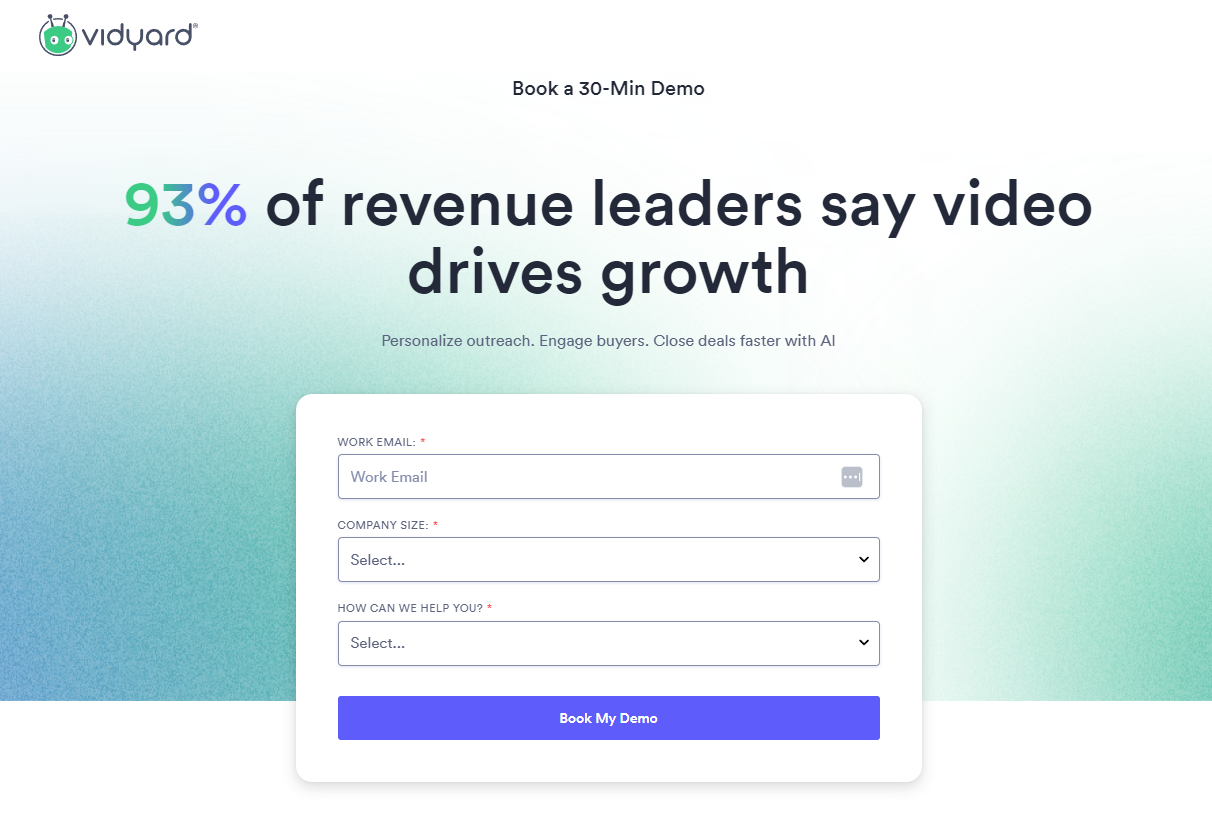
The platform stands out for its personalization capabilities. Vidyard allows users to create customized videos that include the viewer’s name, company, or other personal details. Vidyard also features built-in video recording tools, making it easy to capture screen or webcam content for personalized and professional videos. This personalization significantly increases engagement and conversion rates.
Vidyard’s integration with CRM systems and marketing automation platforms makes it valuable for sales and marketing teams. These connections allow businesses to track video engagement at the contact level and trigger automated workflows based on viewing behavior.
The platform offers comprehensive analytics that go beyond basic metrics. Users can see which parts of their videos viewers watched, skipped, or rewatched. This information helps optimize content for better engagement and conversion.
Features
- Personalized video creation
- Screen recording capabilities
- CRM and marketing automation integrations
- Video engagement scoring
- In-video CTAs and forms
- Team collaboration tools
- Video analytics and heatmaps
- Email integration
- SEO optimization
- Lead scoring based on video engagement
Pros
- Strong marketing and sales features
- CRM integrations
- Personalization options
- Detailed viewer analytics
- User-friendly interface
- Team collaboration tools
Cons
- Limited customization compared to others
- No advanced monetization tools
- Higher pricing for teams
- No China delivery support
9. Hippo Video
Hippo Video combines video creation, hosting, and analytics in one platform. This versatile solution caters to sales, marketing, and customer support teams who want to leverage video in their workflows.
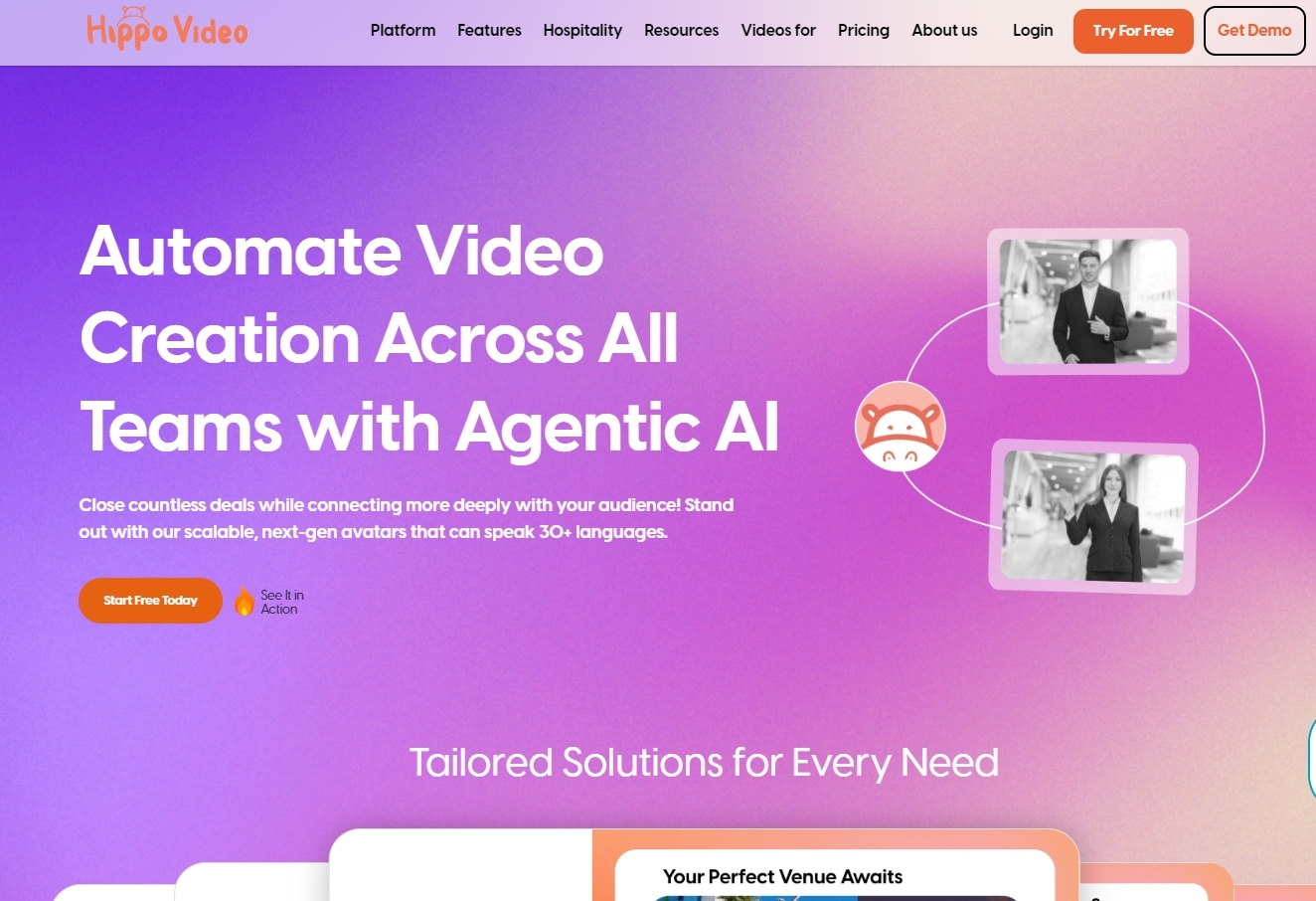
The platform makes video creation simple with its built-in screen recording and editing tools. Users can easily record their screen, webcam, or both, then edit the footage within Hippo Video. Hippo Video also allows users to edit videos directly on the platform, making it easy to customize and enhance content as needed. This streamlined process helps teams create content quickly.
Hippo Video’s integration capabilities set it apart. The platform connects with popular CRM systems, email platforms, and help desks. These integrations allow businesses to incorporate video into their existing workflows and track engagement at the contact level.
The platform’s analytics provide insights into viewer behavior and engagement. These metrics help users optimize their videos for better performance and identify the most engaged prospects or customers.
Features
- Screen recording and webcam capture
- Video editing tools
- Personalization capabilities
- CRM and email integrations
- Video analytics and heatmaps
- In-video CTAs and forms
- Team collaboration features
- Customizable video player
- SEO optimization
- Video distribution tools
Pros
- User-friendly video creation tools
- Strong sales and marketing features
- CRM integrations
- Detailed analytics
- Personalization options
- Team collaboration capabilities
Cons
- Limited advanced customization
- No extensive monetization tools
- Basic live streaming capabilities
- Some features are only available on higher tiers
10. YouTube
YouTube remains the world’s largest video-sharing platform. With billions of monthly users, it offers unparalleled reach and discoverability for content creators. YouTube is an excellent alternative to Vimeo, particularly for creators who focus on a diverse range of content types, including live streaming and gaming. The platform supports both on-demand videos and live streaming.
YouTube stands out for its massive built-in audience. Content creators can reach viewers worldwide without needing to drive traffic themselves. The platform’s recommendation algorithm helps users discover new content based on their viewing habits.
The monetization options on YouTube have expanded significantly. Beyond traditional ad revenue, creators can earn through channel memberships, Super Chat, merchandise shelves, and YouTube Premium revenue sharing. These diverse income streams help creators build sustainable businesses.
YouTube’s analytics provide detailed insights into viewer behavior, demographics, and engagement. These metrics enable creators to optimize their content strategy and expand their audience over time.
Features
- Enormous built-in audience
- Comprehensive video analytics
- Multiple monetization options
- Live streaming capabilities
- Comment and community features
- Video editing tools
- Automatic captioning
- Multi-platform compatibility
- Video SEO and discoverability
- Free unlimited storage
Pros
- Free to use
- Huge potential audience
- Built-in discovery mechanism
- Multiple monetization options
- Reliable infrastructure
- Mobile apps and smart TV support
Cons
- No white-label options
- Limited control over advertising
- Competition for viewer attention
- Content restrictions and policies
- YouTube branding is always present
- Less professional appearance than dedicated hosting
Conclusion
Choosing the right Vimeo alternative depends on your specific needs, budget, and goals. Each platform we’ve reviewed offers unique strengths and capabilities for different use cases.
For most users seeking a balanced, reliable, and cost-effective solution, Castr stands out as our top recommendation. With its transparent pricing, exceptional customer support, and comprehensive features, Castr addresses many of the common frustrations users experience with Vimeo.
Castr offers the perfect combination of professional features, ease of use, and affordability. The platform’s partnership with top-tier CDNs ensures reliable streaming worldwide, while its white-label options maintain your brand identity. Whether you need live streaming capabilities, video hosting, or monetization tools, Castr delivers without hidden limitations.
We encourage you to take advantage of Castr’s free trial to experience these benefits firsthand. You can sign up without a credit card and explore all the features that make it a superior alternative to Vimeo.
Ready to upgrade your video experience? Try Castr today and discover why thousands of content creators, businesses, and streaming professionals have made the switch.
